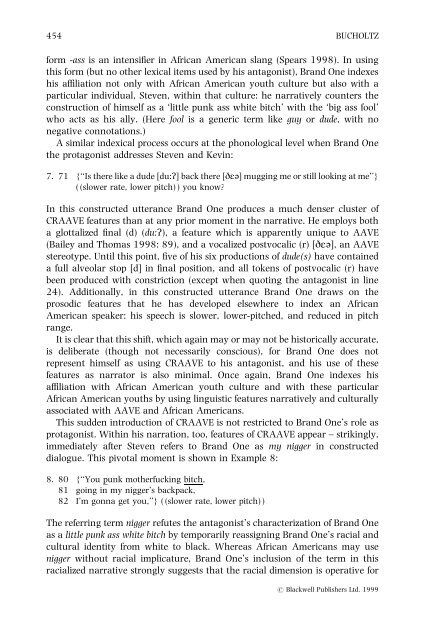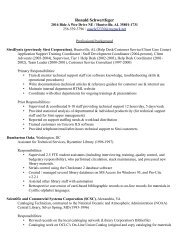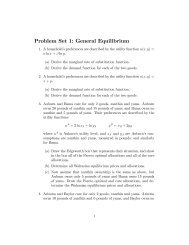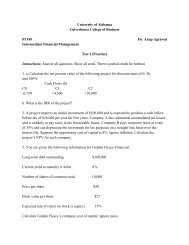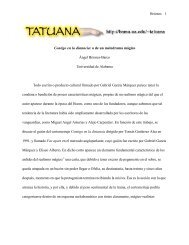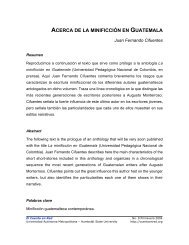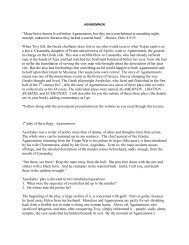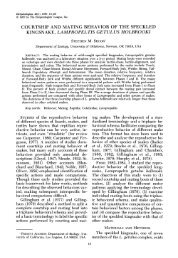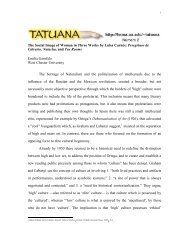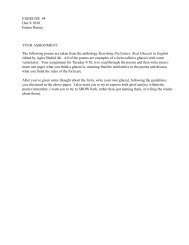You da man: Narrating the racial other in the ... - Bama.Ua.Edu
You da man: Narrating the racial other in the ... - Bama.Ua.Edu
You da man: Narrating the racial other in the ... - Bama.Ua.Edu
Create successful ePaper yourself
Turn your PDF publications into a flip-book with our unique Google optimized e-Paper software.
454<br />
form -ass is an <strong>in</strong>tensi®er <strong>in</strong> African American slang (Spears 1998). In us<strong>in</strong>g<br />
this form (but no o<strong>the</strong>r lexical items used by his antagonist), Brand One <strong>in</strong>dexes<br />
his a liation not only with African American youth culture but also with a<br />
particular <strong>in</strong>dividual, Steven, with<strong>in</strong> that culture: he narratively counters <strong>the</strong><br />
construction of himself as a `little punk ass white bitch' with <strong>the</strong> `big ass fool'<br />
who acts as his ally. (Here fool is a generic term like guy or dude, with no<br />
negative connotations.)<br />
A similar <strong>in</strong>dexical process occurs at <strong>the</strong> phonological level when Brand One<br />
<strong>the</strong> protagonist addresses Steven and Kev<strong>in</strong>:<br />
7. 71 {``Is <strong>the</strong>re like a dude [du:?] back <strong>the</strong>re [DE@] mugg<strong>in</strong>g me or still look<strong>in</strong>g at me''}<br />
( (slower rate, lower pitch) ) you know?<br />
In this constructed utterance Brand One produces a much denser cluster of<br />
CRAAVE features than at any prior moment <strong>in</strong> <strong>the</strong> narrative. He employs both<br />
a glottalized ®nal (d) (du:?), a feature which is apparently unique to AAVE<br />
(Bailey and Thomas 1998: 89), and a vocalized postvocalic (r) [DE@], an AAVE<br />
stereotype. Until this po<strong>in</strong>t, ®ve of his six productions of dude(s) have conta<strong>in</strong>ed<br />
a full alveolar stop [d] <strong>in</strong> ®nal position, and all tokens of postvocalic (r) have<br />
been produced with constriction (except when quot<strong>in</strong>g <strong>the</strong> antagonist <strong>in</strong> l<strong>in</strong>e<br />
24). Additionally, <strong>in</strong> this constructed utterance Brand One draws on <strong>the</strong><br />
prosodic features that he has developed elsewhere to <strong>in</strong>dex an African<br />
American speaker: his speech is slower, lower-pitched, and reduced <strong>in</strong> pitch<br />
range.<br />
It is clear that this shift, which aga<strong>in</strong> may or may not be historically accurate,<br />
is deliberate (though not necessarily conscious), for Brand One does not<br />
represent himself as us<strong>in</strong>g CRAAVE to his antagonist, and his use of <strong>the</strong>se<br />
features as narrator is also m<strong>in</strong>imal. Once aga<strong>in</strong>, Brand One <strong>in</strong>dexes his<br />
a liation with African American youth culture and with <strong>the</strong>se particular<br />
African American youths by us<strong>in</strong>g l<strong>in</strong>guistic features narratively and culturally<br />
associated with AAVE and African Americans.<br />
This sudden <strong>in</strong>troduction of CRAAVE is not restricted to Brand One's role as<br />
protagonist. With<strong>in</strong> his narration, too, features of CRAAVE appear ± strik<strong>in</strong>gly,<br />
immediately after Steven refers to Brand One as my nigger <strong>in</strong> constructed<br />
dialogue. This pivotal moment is shown <strong>in</strong> Example 8:<br />
8. 80 {``<strong>You</strong> punk mo<strong>the</strong>rfuck<strong>in</strong>g bitch,<br />
81 go<strong>in</strong>g <strong>in</strong> my nigger's backpack,<br />
82 I'm gonna get you,''} ( (slower rate, lower pitch) )<br />
BUCHOLTZ<br />
The referr<strong>in</strong>g term nigger refutes <strong>the</strong> antagonist's characterization of Brand One<br />
as a little punk ass white bitch by temporarily reassign<strong>in</strong>g Brand One's <strong>racial</strong> and<br />
cultural identity from white to black. Whereas African Americans may use<br />
nigger without <strong>racial</strong> implicature, Brand One's <strong>in</strong>clusion of <strong>the</strong> term <strong>in</strong> this<br />
<strong>racial</strong>ized narrative strongly suggests that <strong>the</strong> <strong>racial</strong> dimension is operative for<br />
# Blackwell Publishers Ltd. 1999


